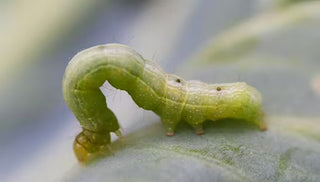At a glance
Crops affected:
- Cabbage-family crops, including cabbage, kale, collard, broccoli, and cauliflower
Controls:
- Garden fabric (row cover) or other barriers
- Bt (Bacillus thuringiensis)

Cabbage looper. Photos: Ann Whitman

Cabbage looper damage and frass.

Cabbage looper egg.
These green inchworms can make a mess of your broccoli and cabbage plants. They chew on foliage, bore holes into cabbage and broccoli heads, and leave behind unsightly black frass (droppings). Cabbage looper damage is annoying, but rarely causes severe crop loss (cabbageworms cause very similar damage). To remove caterpillars from a harvested head of broccoli or cauliflower, just immerse it in salted water. Loopers will feed on any cabbage-family crops, including cabbage, kale, collard, broccoli, and cauliflower.
Cabbage loopers have no legs in the middle of their body; they hump their bodies as they "inch" along. The adult form of this caterpillar is a gray moth that overwinters in warm climates and then migrates north in springtime to lay eggs. Look for these white eggs on the underside of leaves near the leaf edge.
There may be several generations each year, and they're found throughout North America.
Prevention and Control
- In the North, plant a first crop in early spring. You may be able to harvest it before adult moths arrive in your area.
- Cover susceptible plants with garden fabric (row cover) in early spring as a barrier to the egg-laying moths.
- Use Bt (Bacillus thuringiensis)
- If plants are not covered, inspect them frequently. Crush the eggs; handpick the loopers and drop them into a pail of soapy water.
- Encourage native beneficial insects such as parasitic wasps that prey on caterpillars.





